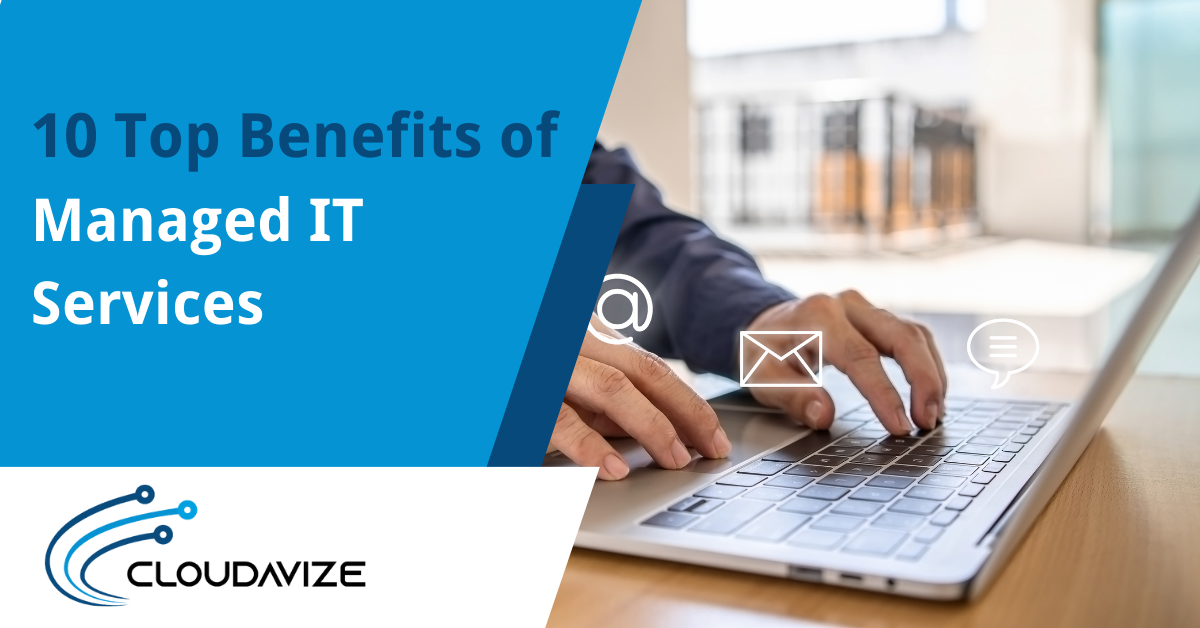Small and mid-sized businesses (SMBs) often struggle with rising IT costs, slow systems, and frequent outages that interrupt operations and drain resources. Limited budgets and small in-house teams cannot keep up with monitoring, patching, or data backup and disaster recovery services, leading to mounting technical debt, security gaps, and compliance challenges under GDPR, HIPAA, and CCPA. The result is a reactive, fragmented IT environment that limits growth and reduces operational efficiency.
To address these issues, businesses across various industries, like healthcare and manufacturing, adopt Managed IT Services, a structured model that delegates ongoing IT operations and support to a specialized partner. This approach replaces reactive management with proactive business enablement, improving stability, predictability, and ROI. Delivering these services are Managed Service Providers (MSPs), specialized third-party vendors offering enterprise-grade solutions, subscription-based pricing models, and Service Level Agreements (SLAs) that guarantee uptime, scalability, and consistent business continuity.
With the right MSP partnership, companies can build a stronger IT foundation and achieve consistent efficiency. Below are the key benefits that show why Managed IT Services have become essential for modern, growth-focused businesses.
- Reduces IT Costs: Cuts unnecessary expenses through fixed and predictable pricing models.
- Enables Predictable IT Budgeting: Simplifies financial planning with transparent MSP cost structures.
- Access to a Team of Experts: Provides specialized, high-level technical support on demand.
- Enhanced Security and Compliance: Provides specialized, high-level technical support on demand.
- Strategic IT Planning and Consulting: Aligns IT with business goals to drive sustainable growth.
- Reduces Network Downtime: Proactively monitors systems to minimize outages and disruptions.
- Enhanced Scalability and Flexibility: Adapts IT infrastructure to match evolving business needs.
- Provide 24/7 Support and Respond Rapidly: Offers continuous monitoring and fast issue resolution.
- Security Awareness Training: Empowers staff to identify and prevent cyber threats effectively.
- Offers Enhanced Cloud Integration: Improves accessibility and collaboration through cloud adoption.

Table of Contents
1. Reduces IT Costs
Managed IT Services lowers IT costs by replacing unpredictable break-fix spending with a subscription-based model that prevents downtime, streamlines vendor management, and optimizes IT assets under clear SLAs.
By centralizing IT operations through a single managed partner, SMBs eliminate the overhead of maintaining separate systems, vendors, and support contracts. Proactive monitoring and preventive measures reduce downtime, while integrated data backup and disaster recovery services protect against costly disruptions.
For instance, Dallas-based SMBs using MSPs report 20–30% annual IT cost reductions by retiring obsolete technology, reducing license duplication, and optimizing infrastructure with enterprise-grade solutions. This model converts capital expenses into predictable operational costs, improving financial accuracy and long-term ROI.
How an MSP lowers your IT spend:
- Fixed and Transparent Pricing: MSPs replace irregular repair expenses with predictable monthly fees tied to performance-based SLAs.
- Reduced Downtime and Recovery Costs: Continuous monitoring minimizes outages, avoiding productivity loss and improving end-user experience.
- Consolidated Vendor Management: A centralized liaison structure eliminates redundant vendors, reduces billing complexity, and improves overall cost efficiency.
2. Enables Predictable IT Budgeting
Through managed IT services, businesses gain the financial predictability needed to plan confidently and avoid the uncertainty of fluctuating IT expenses. Partnering with an MSP transforms irregular spending into fixed monthly costs that cover essential operations such as monitoring, maintenance, and support. This structure allows SMBs to align technology budgets with long-term objectives, improve forecasting accuracy, and maintain tighter control over operational finances.
With transparent pricing models and clearly defined SLAs, all recurring costs from cybersecurity and network management to data backup and disaster recovery services are outlined upfront. According to CompTIA, over 70% of SMBs using MSPs report improved financial predictability and reduced surprise expenses due to subscription-based pricing. This consistency turns IT from an unpredictable expense into a managed investment that supports growth, stability, and measurable ROI.
Key Budgeting Advantages from Managed IT Services:
- Transparent Pricing: SLAs clarify ongoing IT costs and service deliverables.
- Fixed Monthly Fees: Subscription models eliminate unexpected repair and upgrade expenses.
- Improved Financial Planning: Predictable budgets enable smarter allocation and sustainable growth.
3. Access to a Team of Experts
By partnering with an MSP, businesses gain access to a team of certified IT professionals skilled in cybersecurity, cloud infrastructure, and network management. This partnership allows small businesses to access enterprise-grade expertise without the high cost of maintaining full-time specialists. Defined Service Level Agreements ensure fast response times, measurable outcomes, and consistent support often beyond the capacity of small internal IT teams.
Unlike in-house teams that focus mainly on daily troubleshooting, MSP experts provide strategic oversight and long-term direction. Their guidance helps businesses accelerate digital adoption, modernize systems, and align technology investments with business goals. This proactive approach replaces reactive fixes with proactive business enablement, improving uptime, reliability, and ROI.
External expertise also brings a competitive edge through deeper specialization and compliance awareness. MSP professionals stay current on regulations, automation tools, and enterprise-grade solutions, helping organizations reduce technical debt and strengthen overall performance. With scalable expertise and continuous support, small and medium enterprises (SMEs) can achieve sustainable growth while keeping their IT operations future-ready.
4. Enhanced Security and Compliance
Using an MSP helps businesses strengthen cybersecurity defenses while staying compliant with data protection regulations. This is especially valuable for SMBs that handle sensitive financial and customer data but lack the capacity for continuous monitoring and expert oversight.
As cyber threats evolve and compliance standards like GDPR, HIPAA, and CCPA grow more complex, many SMBs struggle to keep systems patched, monitor security logs, or perform regular compliance audits, creating vulnerabilities that can result in costly breaches or fines.
Partnering with an MSP closes these gaps through enterprise-grade protection like Security Information and Event Management (SIEM) platforms, endpoint detection and response (EDR) tools, and intrusion detection systems (IDS) that identify and neutralize risks early. They also manage data backup and disaster recovery services and apply preventive measures to ensure system resilience.
With clearly defined Service Level Agreements ensuring accountability and response times, businesses gain consistent protection and regulatory alignment. This proactive approach minimizes risks, strengthens compliance readiness, and builds customer trust through secure, uninterrupted operations.
5. Strategic IT Planning and Consulting
Managed Service Providers add strategic value to businesses by aligning their IT infrastructure, resources, and investments with measurable business objectives for long-term success. Rather than simply maintaining systems, MSPs provide the vision and technical insight needed to turn information technology into a driver of growth and innovation. Such guidance ensures technology spending supports performance goals, reduces unnecessary costs, and eliminates technical debt that slows scalability and efficiency.
Through dedicated IT consulting and regular infrastructure assessments, MSPs create tailored technology roadmaps that improve planning and decision-making. Their expertise in cloud migration, automation, and digital modernization allows businesses to accelerate digital adoption while staying cost-efficient. Strategic oversight and structured SLAs ensure IT initiatives remain aligned with operational priorities, giving businesses the agility to adapt to market shifts and sustain competitive advantage.
Strategic Planning Advantages from Managed IT Services:
- Aligned IT Strategy: Ensures every technology initiative supports defined business outcomes.
- Operational Efficiency: Identifies and resolves infrastructure gaps to improve performance and reduce waste.
- Future-Ready Growth: Builds agility and innovation into IT planning for sustained long-term ROI.
6. Reduces Network Downtime
By leveraging 24/7 monitoring and proactive management through an MSP, businesses can significantly reduce network downtime and maintain operational stability. Continuous oversight enables early detection of system vulnerabilities, configuration errors, and hardware failures before they escalate into costly outages. This proactive approach reduces service interruptions, protects productivity, and ensures a more reliable end-user experience.
The true value of managed network reliability becomes clear when considering the financial impact of downtime. According to the Ponemon Institute, healthcare organizations lose an average of $7,500 per minute of downtime, and a one-hour outage in a high-volume hospital can exceed $500,000 in losses. MSPs prevent such disruptions through redundancy systems, data backup and disaster recovery services, and defined SLAs that guarantee fast recovery and reliable network continuity.
Here is how MSP-driven downtime reduction works in practice:
- Proactive Monitoring: Real-time visibility detects and resolves issues early.
- Automated Maintenance and Patching: Routine updates and checks prevent cascading failures and dependency issues.
- Assured Continuity: SLAs guarantee uptime reliability and quick recovery.
7. Enhanced Scalability and Flexibility
Managed Service Providers (MSPs) help businesses adapt to growth and changing demands by providing scalable IT infrastructure that expands or contracts without disrupting operations. This capability is especially valuable for small and mid-sized businesses that need to stay agile but often lack the in-house capacity to adjust resources quickly. By aligning infrastructure with real-time demand, MSPs ensure performance remains consistent as the business evolves.
For instance, a retail company experiencing a surge in online transactions during the holiday season can rely on an MSP to increase cloud capacity and network bandwidth instantly. Once demand returns to normal, those resources can be scaled back just as easily, maintaining efficiency without unnecessary costs.
MSPs enable this adaptability through cloud-based systems, virtualization, and flexible pricing models that keep IT resources aligned with actual business usage. This approach reduces technical debt, prevents over-provisioning, and supports smarter long-term investment decisions.
By creating responsive and scalable IT environments, MSPs empower businesses to grow confidently, respond faster to opportunities, and maintain consistent reliability and ROI.
8. Provide 24/7 Support and Respond Rapidly
For businesses that operate beyond traditional hours, maintaining uninterrupted performance requires 24/7 monitoring that an MSP is equipped to provide. Without dedicated oversight, technical issues can go unnoticed until they interrupt workflows, slow productivity, or affect customer delivery.
By partnering with an MSP, organizations gain real-time monitoring, automated alerts, and immediate access to skilled technicians who address issues the moment they appear. This approach ensures consistent system stability and reduces the risk of unexpected downtime.
A practical example comes from a manufacturing company that shifted its after-hours monitoring to an MSP and saw average incident resolution time drop from 4 hours to under 1 hour. This improvement kept production on schedule and prevented avoidable losses during high-demand periods.
With reliable monitoring and rapid-response support available at all times, businesses safeguard performance, maintain operational momentum, and ensure that technical challenges do not disrupt essential processes or customer commitments.
9. Security Awareness Training
Managed IT Services strengthen a company’s security posture by providing structured training programs that help employees recognize and avoid modern cyber threats. Since human error remains one of the most common causes of breaches, improving staff awareness is a core benefit of relying on an MSP.
An MSP uses industry-backed training and real-world benchmarks to improve user behavior. A study from KnowBe4’s 2025 Phishing by Industry Benchmarking Report found that the global phish-prone percentage of employees dropped from 33.1% to 4.1% after a year of continuous security awareness training, reflecting an 86% reduction in employee susceptibility.
By deploying simulated phishing tests, bite-sized lessons, and regular updates on emerging threats, an MSP helps employees build consistent, secure habits. Over time, staff become more confident in identifying suspicious activity and responding correctly.
With stronger awareness across the workforce, businesses experience fewer incidents, improved compliance readiness, and a more resilient security culture that supports safer operations and customer trust.
10. Offers Enhanced Cloud Integration
Businesses outsourcing key IT functions to MSPs gain more efficient, secure cloud integration aligned with day-to-day operations. This is especially valuable for SMEs that want cloud adoption but lack internal resources to manage migrations or tune new environments. MSP support helps ensure a smooth transition without disrupting daily workflows.
MSPs guide each step, from assessing current systems to choosing suitable cloud platforms and moving data or applications with controlled risk. This structured approach contributes to the reliability improvements many businesses report. According to SQ Magazine, 59% of companies experienced increased performance and stability after moving to cloud infrastructure, reflecting how structured cloud adoption can deliver measurable operational gains.
To maintain cloud performance, MSPs manage identity access, secure data handling, and continuous monitoring. These practices reduce misconfigurations, improve accessibility, and support consistent collaboration across remote and on-site teams.
With MSP-led integration, businesses gain scalable and flexible cloud systems that support growth, enhance productivity, and provide a strong foundation for long-term innovation and ROI.
What Are the Benefits of Managed IT Services for Healthcare Organizations?
The primary benefits of managed IT services for the healthcare sector involve maintaining secure, compliant, and consistently available systems that support patient care and protect sensitive medical information. With MSP oversight, healthcare providers can reduce downtime, strengthen HIPAA readiness, improve access to clinical data, and ensure that essential applications remain reliable during high-demand situations.
Key benefits of MSPs for healthcare organizations:
- HIPAA-Aligned Security: MSPs implement encryption, access controls, and continuous monitoring to safeguard patient records.
- Reliable System Uptime: Proactive management prevents outages that disrupt clinical workflows.
- Optimized EHR Systems: Enhanced performance and accessibility for electronic health records.
- Compliance Support: Regular audits and documentation help healthcare providers stay aligned with regulations such as HIPAA, HITECH, and HITRUST.
- Improved Care Delivery: Stable, well-managed IT environments help clinicians focus more on patient outcomes.
Strengthen Your Business Growth by Choosing Managed IT Services
Managed IT Services help businesses accelerate growth by providing secure, scalable, and efficiently managed technology environments that support expanding operational needs. With a Managed Service Provider handling monitoring, maintenance, security, and optimization, organizations avoid technical bottlenecks and gain the freedom to focus on strategy, customers, and innovation instead of daily IT issues.
Across sectors like retail, healthcare, and professional services, businesses have scaled faster and more efficiently after partnering with MSPs who modernize systems and improve performance. By delivering flexibility, stronger uptime, and cost-effective IT management, MSPs act as growth enablers that help organizations stay competitive, adapt to demand changes, and strengthen long-term resilience.



